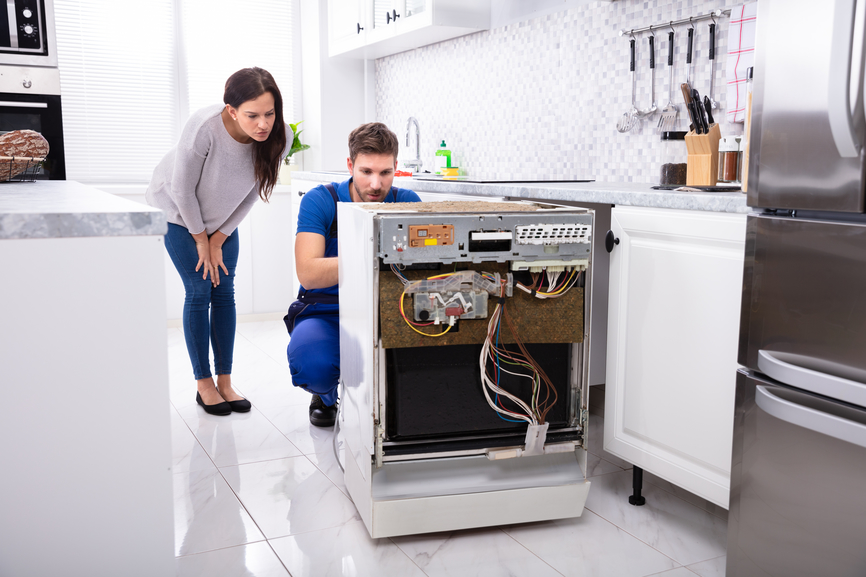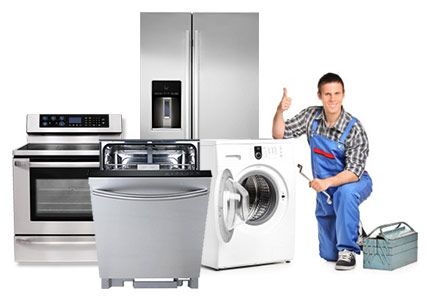The Ultimate Overview to Comprehending Appliance Repair Service at Home
When your fridge stops cooling down or your oven rejects to heat, it can feel overwhelming. Comprehending home appliance repair service in the house can save you time and money. You'll discover to recognize symptoms, utilize important tools, and comply with an organized troubleshooting process. However prior to you start, there are important security preventative measures you require to take right into account. What are the most common problems, and exactly how can you repair them? Let's explore the essentials.
Typical Device Troubles and Their Signs
When your home appliances begin breaking down, it's important to recognize the signs at an early stage. Neglecting them can cause larger issues and expensive repair services. As an example, if your refrigerator isn't cooling down appropriately, you could notice warm places or condensation developing. This could suggest a falling short compressor or an obstructed vent.Your dishwashing machine may reveal issues through dirty meals or unusual sounds throughout cycles. If you hear grinding or clanking, it's time to investigate.A washing equipment that won't spin or drain can leave you with soaked laundry, recommending a blocked drainpipe or a malfunctioning pump.Lastly, if your oven's temperature level seems off or it takes permanently to preheat, you could be dealing with a defective thermostat. By staying sharp to these symptoms, you can resolve concerns before they rise into significant repairs.
Vital Tools for Device Repair Work
When you're taking on appliance repair work at home, having the right devices is important. Basic hand devices like screwdrivers and pliers will help you dismantle and deal with various appliances, while electrical testing devices assure you're functioning safely with wiring. Let's discuss what you require to get started on your repair work journey.
Fundamental Hand Tools
Having the right tools is important for efficient home appliance repair work at home. Start with a reputable screwdriver collection, including both flathead and Phillips kinds, as screws are usual in home appliance setting up. Pliers are likewise essential; they assist with gripping, turning, and reducing cables or tiny components. A set of needle-nose pliers can reach limited spots conveniently. You'll require an excellent flexible wrench for tightening up or loosening up nuts and bolts. An utility blade comes in handy for puncturing packaging or insulation. Don't forget a durable workbench or surface to safely arrange your tools and components. With these fundamental hand tools, you'll be well-prepared to tackle most device fixings that come your method.
Electrical Testing Instruments
Together with standard hand devices, electric screening gadgets play a crucial role in device fixing. These devices help you diagnose electrical concerns and guarantee appliances work safely. A multimeter is essential; it determines voltage, present, and resistance, allowing you to identify troubles quickly. A non-contact voltage tester is another essential, allowing you spot online cords without making straight contact, improving your safety and security. Clamp meters are great for gauging current flow in cords without detaching them, conserving you effort and time. In addition, circuit testers can promptly check if electrical outlets are working effectively. By utilizing these tools, you'll enhance your troubleshooting procedure and improve your repair work skills, making device maintenance a great deal much easier.
Step-by-Step Overview to Diagnosing Device Issues
When your appliance acts up, it can be frustrating, but diagnosing the problem does not need to be frustrating. You'll learn to determine common issues and apply reliable repairing techniques. Allow's stroll with the steps to obtain your device back in working order.
Typical Home Appliance Issues

Fixing Techniques Clarified

Repairing Significant Kitchen Area Home Appliances: A Closer Look
Have you ever questioned just how to tackle usual problems with your kitchen area home appliances? Fixing major kitchen devices like fridges, stoves, and dish washers can be much easier than you think. Begin by identifying the issue-- whether it's a refrigerator not cooling or a stove that won't warm. Commonly, a basic reset or inspecting the source of power can address the issue.For fridges, tidy the condenser coils and examine the door seals. If your stove's not home heating, examine the heating aspect and thermostat. Dishwashers could just need a tidy filter or a reset to obtain them back in activity. Always unplug the device before diving right into repairs to ensure your safety.Don' t neglect to seek advice from the individual manual for details troubleshooting pointers connected to your model. With a little bit of persistence and the right tools, you can confidently deal with device fixings and conserve money at the same time!

Fixing Washing Appliances: Tips and Techniques
When your washing devices start breaking down, it can really feel overwhelming, however troubleshooting them doesn't have to be an inconvenience. Beginning by checking the power supply. Validate the device is plugged in and the outlet is operating. Next, evaluate the door or lid switch; a damaged switch can avoid the maker from operating.For washing machines, if it's not spinning, look for out of balance lots. Redistributing the clothes may address the problem. If your clothes dryer isn't home heating, tidy the lint filter and examine the vent for blockages.Listen for unusual noises; they can suggest a trouble. If your home appliance is dripping, examine the hoses for cracks or loose links. Document any type of error codes shown on electronic displays, try this web-site as they can direct you in recognizing the concern. Ultimately, seek advice from the user handbook for details repairing pointers connected to your version.
Safety Precautions to Take Throughout Services
Prior to you start any type of home appliance fixings, it's necessary to focus on safety and security to stop crashes or injuries. First, unplug the appliance or shut off the breaker to guarantee no power reaches it while you work. Usage protected tools to minimize the risk of electric shock. Put on security goggles and handwear covers to shield yourself from sharp sides or debris (Lg Dryer repair near me Dependable Refrigeration & Appliance Repair Service).Make certain your work space is tidy and well-lit, so you can see what you're doing. Maintain kids and pet dogs away from the area to avoid interruptions and possible hazards. If you're managing gas appliances, be added mindful; check for leaks before proceeding.Take your time, and do not rush via repair work. If you really feel uncertain concerning any type of action, it's better to stop briefly and research than to presume. Complying with these safety measures will certainly aid create a much safer environment for your DIY home appliance repair task
When to Call an Expert for Aid
How do you know if it's time to call in a specialist for home appliance fixings? If you've attempted fundamental troubleshooting without success, it's a clear sign. For circumstances, if your device still won't start or shows uncommon noises after resetting it, don't think twice to look for expert help.When you notice leakages, smoke, or shedding smells, focus on security and call a professional promptly. These concerns can bring about even more significant damages or pose risks to your home.Also, if your home appliance is under guarantee, getting in touch with a specialist is frequently the best route. They can guarantee that repair visit the website services will not nullify your guarantee, saving you click here to find out more money in the long run.Finally, if you're not sure or uneasy with complicated repair work, it's smart to leave it to the professionals. Keep in mind, dealing with complex issues without the appropriate experience can lead to pricey errors. Count on a professional when unsure!
Frequently Asked Questions
Just How Can I Stop Appliance Problems in the Future?
To stop appliance troubles in the future, you must carry out routine maintenance, look for deterioration, clean filters, and prevent overloading. Remaining aggressive will certainly help expand their life expectancy and keep them running efficiently.
What Are one of the most Common Do It Yourself Home Appliance Fixing Mistakes?
You may overlook security preventative measures, avoid fixing steps, or make use of inaccurate tools when trying DIY home appliance repair work. Hurrying the process or ignoring maker guidelines can bring about more substantial concerns and expensive blunders. Stay person and informed!
How Do I Know if a Part Demands Replacement?
You can tell if a component needs substitute by looking for unusual noises, leaks, or irregular performance. If the device struggles to operate properly or reveals noticeable damage, it's likely time for a substitute.
Can I Use Generic Components for Device Repair Works?
Yes, you can utilize common parts for home appliance repair work, however identify they work - Kenmore Dryer Repair Oro Valley Dependable Refrigeration & Appliance Repair Service. Common components may conserve you money, however they might impact efficiency or longevity, so weigh your options very carefully prior to making a decision
What Warranties Cover Device Repairs?
The majority of appliance guarantees cover repair work for making issues, but they typically exclude damage from abuse. Examine your guarantee terms very carefully, as some may need utilizing certified specialists and original parts for coverage to continue to be valid.